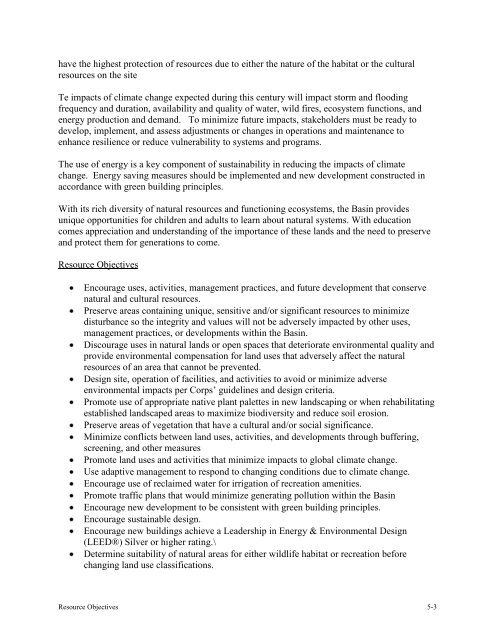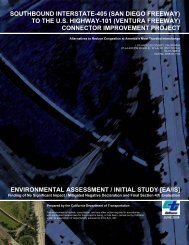Sepulveda Dam Basin Master Plan - Los Angeles District - U.S. Army
Sepulveda Dam Basin Master Plan - Los Angeles District - U.S. Army
Sepulveda Dam Basin Master Plan - Los Angeles District - U.S. Army
- No tags were found...
You also want an ePaper? Increase the reach of your titles
YUMPU automatically turns print PDFs into web optimized ePapers that Google loves.
have the highest protection of resources due to either the nature of the habitat or the culturalresources on the siteTe impacts of climate change expected during this century will impact storm and floodingfrequency and duration, availability and quality of water, wild fires, ecosystem functions, andenergy production and demand. To minimize future impacts, stakeholders must be ready todevelop, implement, and assess adjustments or changes in operations and maintenance toenhance resilience or reduce vulnerability to systems and programs.The use of energy is a key component of sustainability in reducing the impacts of climatechange. Energy saving measures should be implemented and new development constructed inaccordance with green building principles.With its rich diversity of natural resources and functioning ecosystems, the <strong>Basin</strong> providesunique opportunities for children and adults to learn about natural systems. With educationcomes appreciation and understanding of the importance of these lands and the need to preserveand protect them for generations to come.Resource ObjectivesEncourage uses, activities, management practices, and future development that conservenatural and cultural resources.Preserve areas containing unique, sensitive and/or significant resources to minimizedisturbance so the integrity and values will not be adversely impacted by other uses,management practices, or developments within the <strong>Basin</strong>.Discourage uses in natural lands or open spaces that deteriorate environmental quality andprovide environmental compensation for land uses that adversely affect the naturalresources of an area that cannot be prevented.Design site, operation of facilities, and activities to avoid or minimize adverseenvironmental impacts per Corps’ guidelines and design criteria.Promote use of appropriate native plant palettes in new landscaping or when rehabilitatingestablished landscaped areas to maximize biodiversity and reduce soil erosion.Preserve areas of vegetation that have a cultural and/or social significance.Minimize conflicts between land uses, activities, and developments through buffering,screening, and other measuresPromote land uses and activities that minimize impacts to global climate change.Use adaptive management to respond to changing conditions due to climate change.Encourage use of reclaimed water for irrigation of recreation amenities.Promote traffic plans that would minimize generating pollution within the <strong>Basin</strong>Encourage new development to be consistent with green building principles.Encourage sustainable design.Encourage new buildings achieve a Leadership in Energy & Environmental Design(LEED®) Silver or higher rating.\Determine suitability of natural areas for either wildlife habitat or recreation beforechanging land use classifications.Resource Objectives 5-3



